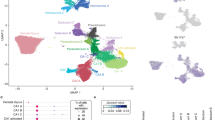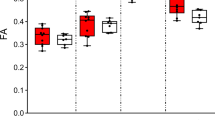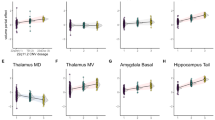Abstract
Working memory capacity, a critical component of executive function, expands developmentally from childhood through adulthood. Anomalies in this developmental process are seen in individuals with autism spectrum disorder (ASD), schizophrenia and intellectual disabilities (ID), implicating this atypical process in the trajectory of developmental neuropsychiatric disorders. However, the cellular and neuronal substrates underlying this process are not understood. Duplication and triplication of copy number variants of 22q11.2 are consistently and robustly associated with cognitive deficits of ASD and ID in humans, and overexpression of small 22q11.2 segments recapitulates dimensional aspects of developmental neuropsychiatric disorders in mice. We capitalized on these two lines of evidence to delve into the cellular substrates for this atypical development of working memory. Using a region- and cell-type-selective gene expression approach, we demonstrated that copy number elevations of catechol-O-methyl-transferase (COMT) or Tbx1, two genes encoded in the two small 22q11.2 segments, in adult neural stem/progenitor cells in the hippocampus prevents the developmental maturation of working memory capacity in mice. Moreover, copy number elevations of COMT or Tbx1 reduced the proliferation of adult neural stem/progenitor cells in a cell-autonomous manner in vitro and migration of their progenies in the hippocampus granular layer in vivo. Our data provide evidence for the novel hypothesis that copy number elevations of these 22q11.2 genes alter the developmental trajectory of working memory capacity via suboptimal adult neurogenesis in the hippocampus.
This is a preview of subscription content, access via your institution
Access options
Subscribe to this journal
Receive 12 print issues and online access
$259.00 per year
only $21.58 per issue
Buy this article
- Purchase on Springer Link
- Instant access to full article PDF
Prices may be subject to local taxes which are calculated during checkout




Similar content being viewed by others
References
Gathercole SE, Pickering SJ, Ambridge B, Wearing H . The structure of working memory from 4 to 15 years of age. Dev Psychol 2004; 40: 177–190.
Gur RC, Richard J, Calkins ME, Chiavacci R, Hansen JA, Bilker WB et al. Age group and sex differences in performance on a computerized neurocognitive battery in children age 8-21. Neuropsychology 2012; 26: 251–265.
Luna B, Garver KE, Urban TA, Lazar NA, Sweeney JA . Maturation of cognitive processes from late childhood to adulthood. Child Dev 2004; 75: 1357–1372.
Woodberry KA, Giuliano AJ, Seidman LJ . Premorbid IQ in schizophrenia: a meta-analytic review. Am J Psychiatry 2008; 165: 579–587.
David AS, Malmberg A, Brandt L, Allebeck P, Lewis G . IQ and risk for schizophrenia: a population-based cohort study. Psychol Med 1997; 27: 1311–1323.
Davidson M, Reichenberg A, Rabinowitz J, Weiser M, Kaplan Z, Mark M . Behavioral and intellectual markers for schizophrenia in apparently healthy male adolescents. Am J Psychiatry 1999; 156: 1328–1335.
Fuller R, Nopoulos P, Arndt S, O'Leary D, Ho BC, Andreasen NC . Longitudinal assessment of premorbid cognitive functioning in patients with schizophrenia through examination of standardized scholastic test performance. Am J Psychiatry 2002; 159: 1183–1189.
Reichenberg A, Caspi A, Harrington H, Houts R, Keefe RS, Murray RM et al. Static and dynamic cognitive deficits in childhood preceding adult schizophrenia: a 30-year study. Am J Psychiatry 2010; 167: 160–169.
Meier MH, Caspi A, Reichenberg A, Keefe RS, Fisher HL, Harrington H et al. Neuropsychological decline in schizophrenia from the premorbid to the postonset period: evidence from a population-representative longitudinal study. Am J Psychiatry 2014; 171: 91–101.
Bora E, Lin A, Wood SJ, Yung AR, McGorry PD, Pantelis C . Cognitive deficits in youth with familial and clinical high risk to psychosis: a systematic review and meta-analysis. Acta Psychiatr Scand 2014; 130: 1–15.
Luna B, Doll SK, Hegedus SJ, Minshew NJ, Sweeney JA . Maturation of executive function in autism. Biol Psychiatry 2007; 61: 474–481.
Rosenthal M, Wallace GL, Lawson R, Wills MC, Dixon E, Yerys BE et al. Impairments in real-world executive function increase from childhood to adolescence in autism spectrum disorders. Neuropsychology 2013; 27: 13–18.
Ackerman PL, Beier ME, Boyle MO . Working memory and intelligence: the same or different constructs? Psychol Bull 2005; 131: 30–60.
Conway AR, Kane MJ, Engle RW . Working memory capacity and its relation to general intelligence. Trends Cogn Sci 2003; 7: 547–552.
Friedman NP, Miyake A, Corley RP, Young SE, DeFries JC, Hewitt JK . Not all executive functions are related to intelligence. Psychol Sci 2006; 17: 172–179.
Danielsson H, Henry L, Ronnberg J, Nilsson LG . Executive functions in individuals with intellectual disability. Res Dev Disabil 2010; 31: 1299–1304.
Danielsson H, Henry L, Messer D, Ronnberg J . Strengths and weaknesses in executive functioning in children with intellectual disability. Res Dev Disabil 2012; 33: 600–607.
Schuchardt K, Gebhardt M, Maehler C . Working memory functions in children with different degrees of intellectual disability. J Intellect Disabil Res 2010; 54: 346–353.
Van der Molen MJ, Van Luit JE, Jongmans MJ, Van der Molen MW . Memory profiles in children with mild intellectual disabilities: strengths and weaknesses. Res Dev Disabil 2009; 30: 1237–1247.
Girirajan S, Eichler EE . Phenotypic variability and genetic susceptibility to genomic disorders. Hum Mol Genet 2010; 19: R176–R187.
Kirov G, Rees E, Walters JT, Escott-Price V, Georgieva L, Richards AL et al. The penetrance of copy number variations for schizophrenia and developmentaldelay. Biol Psychiatry 2013; 75: 378–385.
Malhotra D, Sebat J . CNVs: harbingers of a rare variant revolution in psychiatric genetics. Cell 2012; 148: 1223–1241.
Wentzel C, Fernstrom M, Ohrner Y, Anneren G, Thuresson AC . Clinical variability of the 22q11.2 duplication syndrome. Eur J Med Genet 2008; 51: 501–510.
Yobb TM, Somerville MJ, Willatt L, Firth HV, Harrison K, MacKenzie J et al. Microduplication and triplication of 22q11.2: a highly variable syndrome. Am J Hum Genet 2005; 76: 865–876.
Vaz SO, Pires R, Pires LM, Carreira IM, Anjos R, Maciel P et al. A unique phenotype in a patient with a rare triplication of the 22q11.2 region and new clinical insights of the 22q11.2 microduplication syndrome: a report of two cases. BMC Pediatr 2015; 15: 95.
Wenger TL, Miller JS, DePolo LM, de Marchena AB, Clements CC, Emanuel BS et al. 22q11.2 duplication syndrome: elevated rate of autism spectrum disorder and need for medical screening. Mol Autism 2016; 7: 27.
Hiroi N, Nishi A . Dimensional deconstruction and reconstruction of CNV-associated neuropsychiatric disorders. In: Pletnikov MV, Waddington JL (eds). Modeling the Psychopathological Dimensions of Schizophrenia: From Molecules to Behavior. Handbook of Behavioral Neuroscience, Vol. 23. Academic Press, Elsevier: London, UK, 2015, pp 285–302.
Hiroi N, Takahashi T, Hishimoto A, Izumi T, Boku S, Hiramoto T . Copy Number Variation at 22q11.2: from rare variants to common mechanisms of developmental neuropsychiatric disorders. Mol Psychiatry 2013; 18: 1153–1165.
Suzuki G, Harper KM, Hiramoto T, Funke B, Lee M, Kang G et al. Over-expression of a human chromosome 22q11.2 segment including TXNRD2, COMT, and ARVCF developmentally affects incentive learning and working memory in mice. Hum Mol Genet 2009; 18: 3914–3925.
Hiroi N, Zhu H, Lee M, Funke B, Arai M, Itokawa M et al. A 200- kb region of human chromosome 22q11.2 confers antipsychotic-responsive behavioral abnormalities in mice. Proc Natl Acad Sci USA 2005; 102: 19132–19137.
Dumontheil I, Roggeman C, Ziermans T, Peyrard-Janvid M, Matsson H, Kere J et al. Influence of the COMT genotype on working memory and brain activity changes during development. Biol Psychiatry 2011; 70: 222–229.
Torres-Juan L, Rosell J, Morla M, Vidal-Pou C, Garcia-Algas F, de la Fuente MA et al. Mutations in TBX1 genocopy the 22q11.2 deletion and duplication syndromes: a new susceptibility factor for mental retardation. Eur J Hum Genet 2007; 15: 658–663.
Zweier C, Sticht H, ydin-Yaylagul I, Campbell CE, Rauch A . Human TBX1 missense mutations cause gain of function resulting in the same phenotype as 22q11.2 deletions. Am J Hum Genet 2007; 80: 510–517.
Ogata T, Niihori T, Tanaka N, Kawai M, Nagashima T, Funayama R et al. TBX1 mutation identified by exome sequencing in a Japanese family with 22q11.2 deletion syndrome-like craniofacial features and hypocalcemia. PLoS One 2014; 9: e91598.
Barnett JH, Scoriels L, Munafo MR . Meta-analysis of the cognitive effects of the catechol-O-methyltransferase gene Val158/108Met polymorphism. Biol Psychiatry 2008; 64: 137–144.
Hiramoto T, Kang G, Suzuki G, Satoh Y, Kucherlapati R, Watanabe Y et al. Tbx1: identification of a 22q11.2 gene as a risk factor for autism spectrum disorder in a mouse model. Hum Mol Genet 2011; 20: 4775–4785.
Takahashi T, Okabe S, O'Broin P, Nishi A, Ye K, Beckert M et al. Structure and function of neonatal social communication in a genetic mouse model of autism. Mol Psychiatry 2016; 21: 1208–1214.
Papaleo F, Crawley JN, Song J, Lipska BK, Pickel J, Weinberger DR et al. Genetic dissection of the role of catechol-O-methyltransferase in cognition and stress reactivity in mice. J Neurosci 2008; 28: 8709–8723.
Iwata Y, Suzuki K, Wakuda T, Seki N, Thanseem I, Matsuzaki H et al. Irradiation in adulthood as a new model of schizophrenia. PLoS One 2008; 3: e2283.
Madsen TM, Kristjansen PE, Bolwig TG, Wortwein G . Arrested neuronal proliferation and impaired hippocampal function following fractionated brain irradiation in the adult rat. Neuroscience 2003; 119: 635–642.
Saxe MD, Malleret G, Vronskaya S, Mendez I, Garcia AD, Sofroniew MV et al. Paradoxical influence of hippocampal neurogenesis on working memory. Proc Natl Acad Sci USA 2007; 104: 4642–4646.
Bronson FH, Dagg CP, Snell GD . Reproduction. In: Green EL (ed). Biology of the Laboratory Mouse, 2nd edn. Dover Publications: New York, 2007 (oneline publication).
Tunbridge EM, Harrison PJ, Weinberger DR . Catechol-o-methyltransferase, cognition, and psychosis: Val158Met and beyond. Biol Psychiatry 2006; 60: 141–151.
Hernandez-Rabaza V, Llorens-Martin M, Velazquez-Sanchez C, Ferragud A, Arcusa A, Gumus HG et al. Inhibition of adult hippocampal neurogenesis disrupts contextual learning but spares spatial working memory, long-term conditional rule retention and spatial reversal. Neuroscience 2009; 159: 59–68.
He J, Crews FT . Neurogenesis decreases during brain maturation from adolescence to adulthood. Pharmacol Biochem Behav 2007; 86: 327–333.
Encinas JM, Michurina TV, Peunova N, Park JH, Tordo J, Peterson DA et al. Division-coupled astrocytic differentiation and age-related depletion of neural stem cells in the adult hippocampus. Cell Stem Cell 2011; 8: 566–579.
Spalding KL, Bergmann O, Alkass K, Bernard S, Salehpour M, Huttner HB et al. Dynamics of hippocampal neurogenesis in adult humans. Cell 2013; 153: 1219–1227.
Knoth R, Singec I, Ditter M, Pantazis G, Capetian P, Meyer RP et al. Murine features of neurogenesis in the human hippocampus across the lifespan from 0 to 100 years. PLoS One 2010; 5: e8809.
Dennis CV, Suh LS, Rodriguez ML, Kril JJ, Sutherland GT . Human adult neurogenesis across the ages: an immunohistochemical study. Neuropathol Appl Neurobiol 2016; 42: 621–638.
Kulkarni VA, Jha S, Vaidya VA . Depletion of norepinephrine decreases the proliferation, but does not influence the survival and differentiation, of granule cell progenitors in the adult rat hippocampus. Eur J Neurosci 2002; 16: 2008–2012.
Hoglinger GU, Rizk P, Muriel MP, Duyckaerts C, Oertel WH, Caille I et al. Dopamine depletion impairs precursor cell proliferation in Parkinson disease. Nat Neurosci 2004; 7: 726–735.
Toni N, Laplagne DA, Zhao C, Lombardi G, Ribak CE, Gage FH et al. Neurons born in the adult dentate gyrus form functional synapses with target cells. Nat Neurosci 2008; 11: 901–907.
Zhao C, Teng EM, Summers RG Jr., Ming GL, Gage FH . Distinct morphological stages of dentate granule neuron maturation in the adult mouse hippocampus. J Neurosci 2006; 26: 3–11.
Boku S, Toda H, Nakagawa S, Kato A, Inoue T, Koyama T et al. Neonatal maternal separation alters the capacity of adult neural precursor cells to differentiate into neurons via methylation of retinoic acid receptor gene promoter. Biological Psychiatry 2014; 77: 333–344.
Acknowledgements
We thank Dr Arthur Nienhuis of St. Jude Children’s Research Hospital for providing us with pCL20c-MSCV-EGFP plasmid. Research reported in this publication was supported by the National Institute of Mental Health of the National Institutes of Health under Award Number R01MH099660 (NH), the Eunice Kennedy Shriver National Institute of Child Health and Human Development of the National Institutes of Health under Award Number R21HD053114 and U54HD090260 (NH), National Cancer Institute of the National Institutes of Health under Award Number P30CA013330 (JZ), a NARSAD Independent Investigator Award and a Maltz Foundation award (NH), the Uehara Memorial Foundation and Senshin Medical Research Foundation (SB) and Senshin Medical Research Foundation (HN).The content is solely the responsibility of the authors and does not necessarily represent the official views of the National Institutes of Health. We thank Dr Takeshi Hiramoto for his critical comments on an early version of the manuscript, and Drs J. Roy-Chowdhury and Xia Wang of the Gene Therapy Core, Albert Einstein College of Medicine for preparation of high titer viral particles.
Author contributions
The first three authors (SB, TI and SA) contributed equally to this work. SB, TI, SA, YN, HN, AN, TT, GK, AH, MN, SE and NH contributed to the overall design and execution of experiments and analyses. SB, TI, YN and NH wrote the manuscript. GD-T and PTM conducted Comt enzyme assays. GK, TI, TT conducted behavioral analyses. YN and KT carried out proliferation and apoptosis analyses in vitro. SA, HN, YN, JZ and NH conducted FACS. SK and KK provided the template plasmid of viral vectors and SB designed viral vectors. SB, TI, SA, AN, TT, AH, SE and MN carried out histochemical analyses.
Author information
Authors and Affiliations
Corresponding author
Ethics declarations
Competing interests
The authors declare no conflict of interest.
Additional information
Supplementary Information accompanies the paper on the Molecular Psychiatry website
Supplementary information
Rights and permissions
About this article
Cite this article
Boku, S., Izumi, T., Abe, S. et al. Copy number elevation of 22q11.2 genes arrests the developmental maturation of working memory capacity and adult hippocampal neurogenesis. Mol Psychiatry 23, 985–992 (2018). https://doi.org/10.1038/mp.2017.158
Received:
Revised:
Accepted:
Published:
Issue Date:
DOI: https://doi.org/10.1038/mp.2017.158
This article is cited by
-
Connecting DCX, COMT and FMR1 in social behavior and cognitive impairment
Behavioral and Brain Functions (2022)
-
Tbx1, a gene encoded in 22q11.2 copy number variant, is a link between alterations in fimbria myelination and cognitive speed in mice
Molecular Psychiatry (2022)
-
Computational identification of variables in neonatal vocalizations predictive for postpubertal social behaviors in a mouse model of 16p11.2 deletion
Molecular Psychiatry (2021)
-
Assessing auditory processing endophenotypes associated with Schizophrenia in individuals with 22q11.2 deletion syndrome
Translational Psychiatry (2020)



